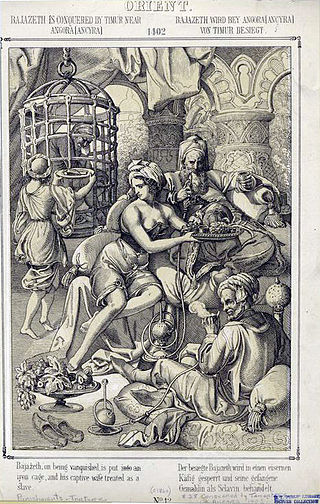Top Qs
Timeline
Chat
Perspective
Olivera Lazarević
Wife of Sultan Bayezid I From Wikipedia, the free encyclopedia
Remove ads
Marija Olivera Lazarević (Serbian Cyrillic: Марија Оливера Лазаревић; 1372 – after 1444), or Olivera Despina Hatun, was a Serbian princess and consort of the Ottoman sultan Bayezid I, whom she married just after the Battle of Kosovo in 1389 as a pledge of peace between the Lazarević and Ottoman dynasties. She was the youngest daughter of Lazar of Serbia and Princess Milica.
Remove ads
The story of Olivera's and Bayezid's captivity by Timur after the Battle of Ankara (1402) has been popularly narrated, most often in plays and operas. The most significant one is Tamburlaine (1587–1588) by Christopher Marlowe, in which she is named “Zabina”.
Remove ads
Biography
Summarize
Perspective

Olivera was born around 1372, the youngest daughter of Prince Lazar and Princess Milica of Serbia.[1] Her mother was a descendant of Grand Prince (Veliki Župan) Stefan Nemanja, the founder of the Nemanjić dynasty and the fourth cousin once removed of Emperor Dušan of Serbia.[2] Olivera had four older sisters—Mara (mother of Serbian despot Đurađ Branković), Dragana, Teodora, and Jelena (mother of Balša III, the last ruler of Zeta)—and two younger brothers—Serbian despot Stefan Lazarević and Vuk.[1][2]

After the Battle of Kosovo in 1389, Olivera was sent to the harem of Sultan Bayezid I where she remained for the next 12 years. They had three daughters: Öruz Hatun, Paşa Melek Hatun and another unnamed daughter. Despite her marriage, she apparently never converted to Islam.[2] She had a considerable influence over the sultan, which helped her people, country, and family survive in turbulent times.[citation needed]

In the Battle of Ankara on 20 July 1402, Olivera and Bayezid were captured by Timur.[2][3] According to some accounts, Bayezid was allegedly chained, and forced to watch how his beloved wife, Olivera, served Timur at dinner.[4] Olivera was widowed in 1403.[1] A Ragusan chronicler Mavro Orbini wrote in the Kingdom of the Slavs (1601) that she died in captivity two days after Bayezid's death, which is incorrect.[2] Serbian soldier and memoirist Konstantin Mihailović noted that Timur felt remorse for Bayezid's death and released his delegation, including his wife.[2] After her release, she spent the rest of her life at the court of her brother Stefan in Belgrade and at the court of her sister Jelena in Herceg Novi. There she became a patron of art and literature. Olivera died around 1444.[1][2]
Remove ads
Issue
By Bayezid, she had two daughters:[4][5]
- Öruz Hatun. In 1403, she married Abu Bakr Mirza, son of Mirza Celaleddin Miranşah, son of Timur. Öruz had at least a child, a daughter, Ayşe.
- Paşa Melek Hatun. In 1403, in Samarkand, she married Şemseddin Mehmed, son of Emîr Celaluddîn İslâm, a general of Timur.
In fiction
The story of Olivera's and Bayezid's captivity has been popularly narrated, most often through plays and operas.[3][2] The most significant one is Tamburlaine (1587–1588) by Christopher Marlowe, English playwright and poet of the Elizabethan era.[3][2] In the play, she is named ”Zabina”. [3][2] According to the story, Timur (Tamerlane) kept Bayezid (Bajazeth) in an iron cage while Zabina was forced to serve him as a slave.[3][2] In the end, they both committed suicide.[3][2] The same story, which included Olivera, was used in Tamerlan, ou la mort de Bajazet (1676) by Jacques Pradon, Bajazeth und Tamerlan (1690) by Johann Philipp Förtsch, and Timour the Tartar (1811) by Matthew Lewis.[2]
See also
- Mara Branković (Mara Despina Hatun)
References
Sources
External links
Wikiwand - on
Seamless Wikipedia browsing. On steroids.
Remove ads

